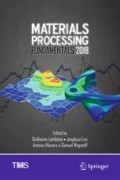Abstract
Currently, there is an increasing interest to produce energy mainly from renewable sources such as biomass. However, fouling, slagging and corrosion threaten long-term operation availability and costs of biomass power plants. Alkali metal elements in the biomass fuel and the ash fusion behavior are the two major origins contributing to slagging during high-temperature biomass combustion. Accumulated slags decrease thermal efficiency of superheaters. These slags often constitute a considerable percentage of complex inorganic phases such as K2Ca2(SO4)3. However, thermodynamic properties of these inorganic phases and their combined effect, which would help to solve the fouling, slagging and high-temperature corrosion related problems in biomass combustion processes, are not well known. In the present work, thermodynamics and phase equilibria of selected phases in the K2SO4–CaSO4 system were both critically reviewed and experimentally studied. The obtained results are presented and discussed.
Access this chapter
Tax calculation will be finalised at checkout
Purchases are for personal use only
References
EC 2009 A—Renewable Energies Directive, 2009/28/EC of 23 April 2009
Official Statistics of Finland (OSF): Energy supply and consumption. ISSN = 1799–7976. 1st Quarter 2013. Helsinki: Statistics Finland [referred: 25 Sept 2015]. Access method: http://www.tilastokeskus.fi/til/ehk/2013/01/ehk_2013_01_2013-06-20_tie_001_en.html
Vamvuka D, Zografos D, Alevizos G (2008) Control methods for mitigating biomass ash-related problems, in fluidized beds. Bioresour Technol 99:3534–3544
Pettersson A, Amand LE, Steenari BM (2009) Chemical fractionation for the characterization of fly ashes from co-combustion of biofuels using different methods for alkali reduction. Fuel 88:1758–1772
Niu Y, Tan H, Wang X, Liu Z, Liu Y, Xu T (2010) Study on deposits on the surface, upstream, and downstream of bag filters in a 12 MW biomass-fired boiler. Energy Fuels 24:2127–2132
Karlsson S, Åm L-E, Liske J (2015) Reducing high-temperature corrosion on high-alloyed stainless steel superheaters by co-combustion of municipal sewage sludge in a fluidised bed boiler. Fuel 139:482–493
Zhu Y, Niu Y, Tan H, Wang X (2014) Short review on the origin and countermeasure of biomass slagging in grate furnace, 2014, Front. Energy Res 2(7), https://doi.org/10.3389/fenrg.2014.00007
Yang Y, Xiao Y, Voncken JHL, Wilson N (2007) Thermal treatment and vitrification of boiler ash from a municipal solid waste incinerator. https://doi.org/10.1016/j.jhazmat.2007.10.116
Frandsen FJ (2005) Utilizing biomass and waste for power production—a decade of contributing to the understanding, interpretation and analysis of deposits and corrosion products. Fuel 84:1277–1294
Mueller C, Skrifvars B-J, Backman R, Hupa M (2003) Ash deposition prediction in biomass fired fluidised bed boilers—combination of CFD and advanced fuel analysis. Prog Comput Fluid Dyn 3:113–120
Rowe JJ, Morey GW, Zen CS (1972) The quinary reciprocal salt systems Na, K, Mg, Ca/Cl, SO4; a review of the literature with new data, Professional Paper 741, U.S. Govt. Print. Off., 37p. http://pubs.usgs.gov/pp/0741/report.pdf. Accessed Aug 2017
Rowe JJ, Morey GW, Silber CC (1967) Ternary system K2SO4-MgSO4-CaSO4. J Inorg Nucl Chem 29:925–942
Ramsdell LS (1935) An x-ray study of the system K2SO4-MgSO4-CaSO4. Am Mineral 20:569–574
Cao H, Boerio-Goates J (1994) Heat-capacity measurements and thermodynamic functions of langbeinite-type K2Cd2(SO4)3 and K2Ca2(SO4)3 at temperatures from 10 K to 340 K. J Chem Therm 26:251–259
Tian H, Guo Q, Yue X, Liu Y (2010) Investigation into sulfur release in reductive decomposition of calcium sulfate oxygen carrier by hydrogen and carbon monoxide. Fuel Process Technol 91:1640–1649
Morey GW, Rowe JJ, Fournier RO (1964) The system K2Mg2(SO4)3 (Langbeinite)—K2Ca2(SO4)3 (Calcium-Langbeinite). J Inorg Nucl Chem 26:53–58
Speer D, Salje E (1986) Phase transitions in langbeinites I: crystal chemistry and structures of K-double sulfates of the langbeinite type M2 ++K2(SO4)3, M++=Mg, Ni, Co, Zn, Ca. Phys Chem Miner 13:17–24
Mukimov SM et al (1949) The study of intersection of melt sulfates of Na, K, Mg and Ca, Tr. Inst. Khim. Nauk Uzb. SSR. Inst. Khim. Obsheh. Neorg. Khim., 2:94–112 (in Russia)
Roine A et al (2010) HSC Chemistry, version 6, Outotec Finland Oy, Research Center
Barin I Thermochemical Data of Pure Substances. Part I & II, VCH Verlagsgesellschaft, Weinheim/VCH Publishers, New York, USA
Robie RA, Russell-Robinson S, Hemingway BS (1989) Heat capacities and entropies from 8 to 1000 K of langbeinite (K2Mg2(SO4)3), anhydrite (CaSO4) and of gypsum (CaSO4·2H2O). Thermoch Acta 139:67–81
Acknowledgements
The authors are grateful to the Academy of Finland for financial support. This work was made under the project “Thermodynamic investigation of complex inorganic material systems for improved renewable energy and metals production processes” as part of the activities of the Johan Gadolin Process Chemistry Center at Åbo Akademi University.
Author information
Authors and Affiliations
Corresponding author
Editor information
Editors and Affiliations
Rights and permissions
Copyright information
© 2018 The Minerals, Metals & Materials Society
About this paper
Cite this paper
Tesfaye, F., Lindberg, D., Hupa, L. (2018). The K2SO4–CaSO4 System and Its Role in Fouling and Slagging During High-Temperature Processes. In: Lambotte, G., Lee, J., Allanore, A., Wagstaff, S. (eds) Materials Processing Fundamentals 2018. TMS 2018. The Minerals, Metals & Materials Series. Springer, Cham. https://doi.org/10.1007/978-3-319-72131-6_11
Download citation
DOI: https://doi.org/10.1007/978-3-319-72131-6_11
Published:
Publisher Name: Springer, Cham
Print ISBN: 978-3-319-72130-9
Online ISBN: 978-3-319-72131-6
eBook Packages: Chemistry and Materials ScienceChemistry and Material Science (R0)

